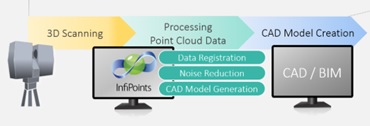What does 3D Scan Operator do?
As a 3D scan operator, you’re responsible for capturing real-world environments and transforming them into digital models. Your role combines technical precision with creativity, as you help lay the digital foundation for everything from infrastructure design to virtual reconstructions.
Here’s what your daily work includes:
- Scan planning and preparation
You carefully plan each scan by selecting the best positions and adjusting equipment settings. This ensures that every detail is captured with accuracy.
- Performing scans
Using laser scanners and photogrammetry tools, you conduct high-precision scans of buildings, objects, or environments.
- Quality control
After each scan, you check the data for accuracy and technical issues, making sure it’s clean and usable.
- Data processing
You convert raw scan data into point clouds and mesh models using specialized software.
- Generating 3D models
You bring the digital models to life by adding textures and refining the geometry to make the scan visually accurate and application-ready.
This role is not only technically challenging but also highly creative and impactful. Whether you’re contributing to a city renovation plan, supporting industrial design, or helping preserve historical landmarks, your work helps bridge the physical and digital worlds.

Why your work matters
3D scanning is reshaping the way we design, build, and preserve our world. Your work as a scan operator is essential in industries that depend on precision, safety, and visualization. Here’s why it matters:
- Precision and efficiency
Your scans improve planning accuracy in construction, product design, and engineering—reducing errors and saving time.
- Cultural preservation
By documenting historical buildings and artifacts, you help protect cultural heritage for future generations.
- Innovation in design
Your data enables researchers, architects, and planners to create smarter, more sustainable solutions.
- Safety and analysis
In industries like infrastructure and energy, your scans help assess risk, monitor conditions, and improve safety planning.
You’re not just using a scanner—you’re capturing information that fuels better decisions, safer environments, and innovative ideas.
The role of geo-information in your work
Geo-information plays a central role in every step of the 3D scanning process. It gives your scans spatial context, allowing them to be accurately aligned, interpreted, and applied across projects. Here’s how geo-information supports your work:
- Precise location tracking
You use coordinates and mapping systems to determine the exact position of each scan point.
- Efficient scan planning
Geo-information helps you plan optimal scan paths, ensuring full coverage and reducing errors.
- Analysis and modeling
With geospatial data, you can place your models in a broader context—helping clients visualize how a scanned object or site fits into its environment.
Understanding and applying geo-information makes your work more accurate, efficient, and valuable across a range of sectors.

